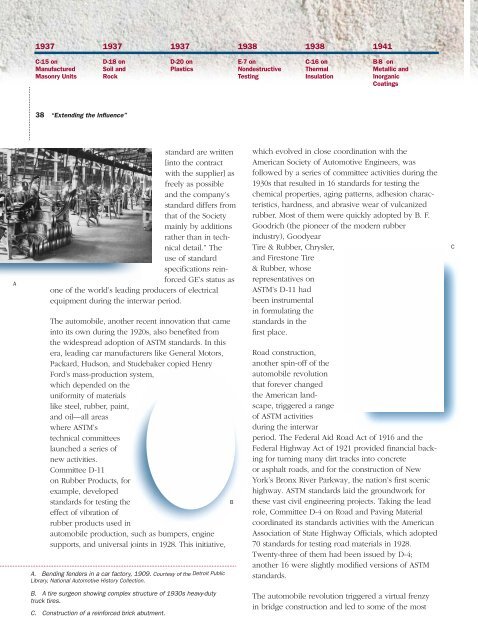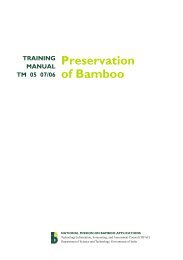ASTM
Create successful ePaper yourself
Turn your PDF publications into a flip-book with our unique Google optimized e-Paper software.
1937<br />
1937<br />
1937<br />
1938<br />
1938<br />
1941<br />
C-15 on<br />
Manufactured<br />
Masonry Units<br />
D-18 on<br />
Soil and<br />
Rock<br />
D-20 on<br />
Plastics<br />
E-7 on<br />
Nondestructive<br />
Testing<br />
C-16 on<br />
Thermal<br />
Insulation<br />
B-8 on<br />
Metallic and<br />
Inorganic<br />
Coatings<br />
38 “Extending the Influence”<br />
A<br />
standard are written<br />
[into the contract<br />
with the supplier] as<br />
freely as possible<br />
and the company’s<br />
standard differs from<br />
that of the Society<br />
mainly by additions<br />
rather than in technical<br />
detail.” The<br />
use of standard<br />
specifications reinforced<br />
GE’s status as<br />
one of the world’s leading producers of electrical<br />
equipment during the interwar period.<br />
The automobile, another recent innovation that came<br />
into its own during the 1920s, also benefited from<br />
the widespread adoption of <strong>ASTM</strong> standards. In this<br />
era, leading car manufacturers like General Motors,<br />
Packard, Hudson, and Studebaker copied Henry<br />
Ford’s mass-production system,<br />
which depended on the<br />
uniformity of materials<br />
like steel, rubber, paint,<br />
and oil—all areas<br />
where <strong>ASTM</strong>’s<br />
technical committees<br />
launched a series of<br />
new activities.<br />
Committee D-11<br />
on Rubber Products, for<br />
example, developed<br />
standards for testing the<br />
effect of vibration of<br />
rubber products used in<br />
automobile production, such as bumpers, engine<br />
supports, and universal joints in 1928. This initiative,<br />
A. Bending fenders in a car factory, 1909. Courtesy of the Detroit Public<br />
Library, National Automotive History Collection.<br />
B<br />
which evolved in close coordination with the<br />
American Society of Automotive Engineers, was<br />
followed by a series of committee activities during the<br />
1930s that resulted in 16 standards for testing the<br />
chemical properties, aging patterns, adhesion characteristics,<br />
hardness, and abrasive wear of vulcanized<br />
rubber. Most of them were quickly adopted by B. F.<br />
Goodrich (the pioneer of the modern rubber<br />
industry), Goodyear<br />
Tire & Rubber, Chrysler,<br />
and Firestone Tire<br />
& Rubber, whose<br />
representatives on<br />
<strong>ASTM</strong>’s D-11 had<br />
been instrumental<br />
in formulating the<br />
standards in the<br />
first place.<br />
Road construction,<br />
another spin-off of the<br />
automobile revolution<br />
that forever changed<br />
the American landscape,<br />
triggered a range<br />
of <strong>ASTM</strong> activities<br />
during the interwar<br />
period. The Federal Aid Road Act of 1916 and the<br />
Federal Highway Act of 1921 provided financial backing<br />
for turning many dirt tracks into concrete<br />
or asphalt roads, and for the construction of New<br />
York’s Bronx River Parkway, the nation’s first scenic<br />
highway. <strong>ASTM</strong> standards laid the groundwork for<br />
these vast civil engineering projects. Taking the lead<br />
role, Committee D-4 on Road and Paving Material<br />
coordinated its standards activities with the American<br />
Association of State Highway Officials, which adopted<br />
70 standards for testing road materials in 1928.<br />
Twenty-three of them had been issued by D-4;<br />
another 16 were slightly modified versions of <strong>ASTM</strong><br />
standards.<br />
C<br />
B. A tire surgeon showing complex structure of 1930s heavy-duty<br />
truck tires.<br />
C. Construction of a reinforced brick abutment.<br />
The automobile revolution triggered a virtual frenzy<br />
in bridge construction and led to some of the most




